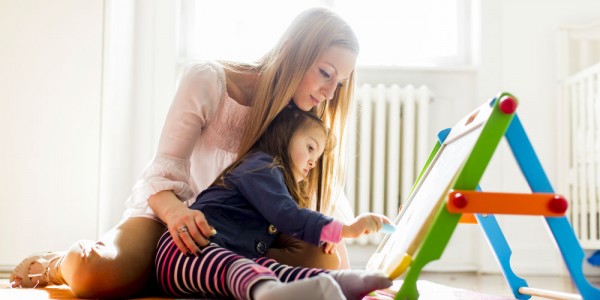When older children are adopted, they often arrive in our homes with various worries, insecurities, issues, or emotional gaps. Sometimes they are serious enough to require counseling to help them grow into healthy, well-developed, secure children. Other times, they just might need a little “at-home therapy.”
In the three years that my daughter, Hannah, has been in my life (adopted at age six, now nine), I have tried to provide her with opportunities to learn about families, become empathetic, express her emotions, and deal with her grief. Here are a few examples of at-home therapy activities we have done.
Learning to Play
After three years in an orphanage, Hannah did not know how to play by herself—I had to teach her. I sat on the floor and played games by myself, letting her watch. I set up stuffed animals and did skits, with all the voices and appropriate sounds. I drew pictures, all the while talking out loud to myself about what I was drawing and what I thought about it. I rolled cars across the floor, with loud “vrooming” noises, and created garages, bridges, and parking lots. By modeling “playing” for my daughter, she learned not only how to play but also how to express herself.
Adoption Journal
Hannah’s past is very much a part of her present. When she was just learning to write at age six, I bought her a blank journal that we called her Adoption Journal. I explained that the journal was a place where she could share her feelings about her birth family and other adoption-related topics. I suggested that she could draw pictures, write letters, or write a list of words.
Our Story
The telling and retelling of our story is part of our history. “Once upon a time there was a woman named Susan. In Russia, there was a little girl . . .” In an effort to help affirm that she’s my daughter forever, I always project the story into the future with positive speculations about getting a dog, taking trips together, and visiting Hannah at college.
Fill in the Blank
I write short four to five sentence stories with blanks to be filled in by Hannah. They usually relate to a topic or issue we’ve been discussing or that she has been stressed over. “One Saturday, there was a very sad dog named ______. He walked with his head down thinking about ______. After a long walk, he realized that he wasn’t really sad, he was ______. He decided to go and talk to ______ about his feelings. After their long talk, he said, “______________________.”
Emotion Games
Hannah had not been exposed to adults who took the time to teach her about emotions. Once she arrived in the United States and was learning English, she needed to relearn the few emotion words she did know in Russian. We got a sheet of paper from a therapist with multiple faces showing not only sad, mad, glad, but also lonely, worried, frustrated, annoyed, and more. We mimicked them, discussed them, and play-acted the emotions. We also took turns making our faces into various emotions and having the other person guess the emotion.
Anger Practice
Hannah struggled with rage, which stemmed from her attachment disorder. She had never been taught how to properly express anger in an appropriate way. (In her orphanage, any children having a tantrum or expressing anger were medicated.) When she was calm, we had anger practice. I would have her pretend to feel anger, then resolve it by running up and down the stairs, pounding on the bed, kicking a pillow, and taking deep breaths.
Our children who were adopted at an older age sometimes need extra assistance as they learn and develop. Doing your own version of at-home therapy helps you bond with your child, and helps her to grow into a comfortable, confident individual.

